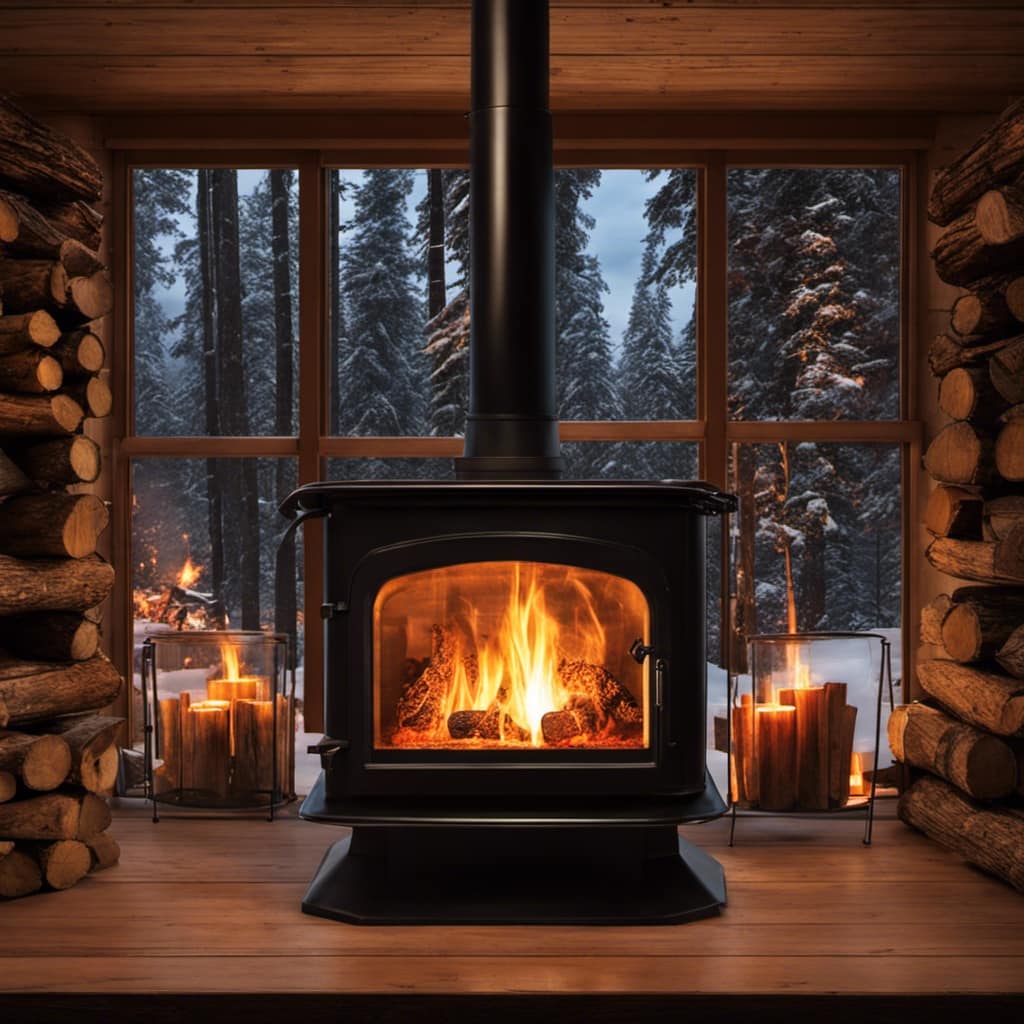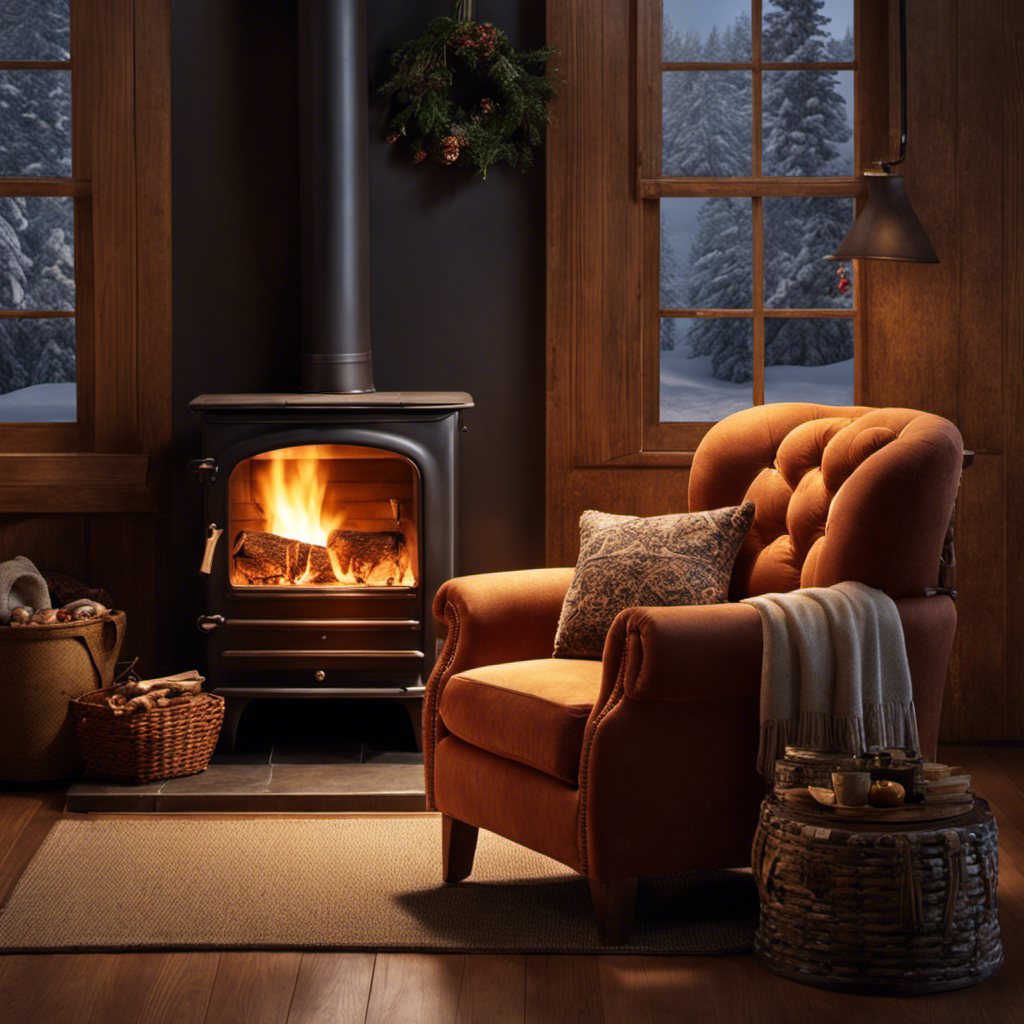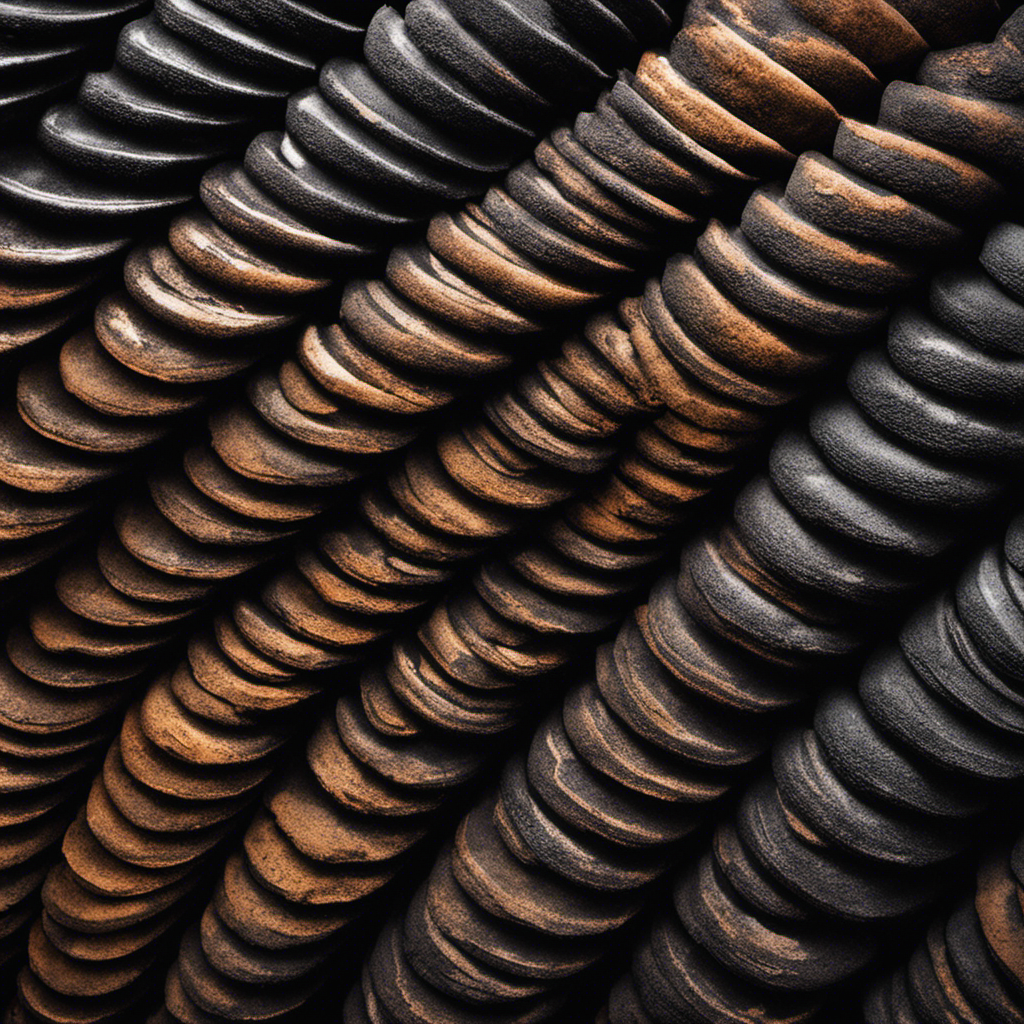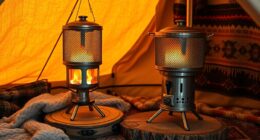Having spent a significant amount of time using wood stoves, I can attest to the fact that allowing creosote to accumulate can result in significant issues.
But fear not! In this article, I’ll reveal the secrets to burning your wood stove efficiently and minimizing creosote formation.
From understanding the causes of buildup to proper wood selection and maintenance tips, I’ve got you covered.
So, sit back, relax, and let’s dive into the world of wood stove burning without the pesky creosote.

Key Takeaways
- Burning seasoned wood reduces creosote buildup
- Proper airflow and burning small, hot fires minimize creosote formation
- Regular maintenance and cleaning prevent creosote buildup and ensure safe operation
- Professional inspection and chimney cleaning are important for safety and efficiency
Understanding the Causes of Creosote Buildup
I’ve noticed that understanding the causes of creosote buildup is crucial for preventing it in my wood stove. Creosote is a black, tar-like substance that forms when wood burns incompletely. It’s made up of unburned wood particles, water vapor, and various chemicals.
There are several factors that contribute to the formation of creosote. Firstly, burning unseasoned or wet wood can lead to incomplete combustion, resulting in more creosote buildup. Additionally, restricted airflow in the stove can cause the wood to burn at a lower temperature, increasing the production of creosote.
It’s important to be aware of the dangers of creosote buildup, as it can lead to chimney fires and poor air quality. By understanding the causes of creosote formation, I can take the necessary steps to prevent it in my wood stove.
Transitioning into the subsequent section about proper wood selection and preparation techniques, I can ensure a safer and more efficient burning process.

Proper Wood Selection and Preparation Techniques
To ensure cleaner and more efficient burning, I always make sure to select and properly prepare the right type of firewood for my wood stove.
One of the key factors in achieving this is wood seasoning. Seasoned wood refers to wood that has been left to dry for an extended period of time, typically around 6-12 months. This allows the moisture content to reduce significantly, usually to around 20% or less.
The lower the moisture content, the better the wood will burn. Moisture in wood not only reduces its energy output, but it also contributes to the buildup of creosote in the chimney.
Efficient Burning Techniques for Minimizing Creosote Formation
By properly selecting and preparing seasoned firewood, I can ensure more efficient burning and reduce the formation of creosote in my chimney.

Efficient burning techniques are essential for minimizing creosote formation and maximizing the heat output of my wood stove. One technique is to create a good draft by opening the damper fully and keeping the air vents open. This allows for proper oxygen flow and ensures complete combustion.
Another technique is to burn small, hot fires instead of large, smoldering ones. This helps to prevent the buildup of unburned particles and reduces the amount of smoke produced.
Additionally, I can avoid burning wet or unseasoned wood, as this leads to incomplete combustion and increased creosote formation.
By employing these efficient burning techniques, I can enjoy a cleaner, more efficient wood burning experience.

Now, let’s explore some regular maintenance and cleaning tips for my wood stove.
Regular Maintenance and Cleaning Tips for Your Wood Stove
Regularly cleaning and inspecting my chimney and flue can help prevent the buildup of debris and ensure the safe and efficient operation of my wood stove. Here are three key steps to include in your maintenance schedule:
-
Clean the chimney and flue at least once a year using specialized cleaning products. These products are designed to effectively remove creosote and other flammable deposits that can accumulate over time.
-
Inspect the chimney for any signs of damage, such as cracks or loose bricks. This is important to ensure that the chimney is structurally sound and can effectively vent the smoke and gases produced by the wood stove.

-
Check the chimney cap and spark arrestor regularly to make sure they’re in good condition. These components prevent debris, animals, and sparks from entering the chimney, reducing the risk of chimney fires.
By following these maintenance tips and incorporating a regular cleaning schedule, you can minimize the buildup of creosote in your chimney and ensure the safe and efficient operation of your wood stove.
To further ensure the safety and performance of your wood stove, it’s important to schedule a professional inspection and chimney cleaning at least once a year.
Professional Inspection and Chimney Cleaning: Why It’s Important
I recently scheduled a professional inspection and chimney cleaning for my wood stove to ensure its safety and performance.

It’s important to regularly maintain and clean your wood stove to prevent dangerous build-ups of creosote, a highly flammable residue that can accumulate in the chimney.
A professional inspection involves a thorough examination of the stove, chimney, and venting system to identify any potential issues or hazards. This includes checking for blockages, leaks, or damaged components.
Additionally, a professional chimney cleaning involves the removal of creosote and other debris that may have accumulated over time. This not only improves the efficiency and performance of the wood stove but also reduces the risk of chimney fires.
Frequently Asked Questions
Can I Burn Any Type of Wood in My Wood Stove?
Yes, you can burn various types of firewood in your wood stove. However, it is important to consider their burning efficiency. Certain types, like well-seasoned hardwoods, burn more efficiently and produce less creosote buildup.

How Often Should I Clean My Wood Stove to Prevent Creosote Buildup?
I clean my wood stove regularly to prevent creosote buildup. It’s important to follow best practices for wood stove maintenance. Regular cleaning helps to ensure efficient burning and reduces the risk of chimney fires.
Are There Any Alternative Methods to Burning Wood That Can Reduce Creosote Formation?
Using alternative fuels such as pellets or compressed logs can reduce creosote formation in wood stoves. Regular maintenance, like cleaning and proper airflow, is also crucial to prevent creosote buildup and ensure efficient burning.
Can I Use Chemical Cleaners to Remove Creosote From My Chimney?
Using chemical cleaners to remove creosote from your chimney is not recommended. The effectiveness is limited, and there are safety precautions to consider. It’s best to prevent creosote buildup by burning wood properly in your wood stove.
How Often Should I Have My Wood Stove Professionally Inspected and Cleaned?
Having a wood stove professionally inspected and cleaned regularly is crucial for proper wood stove maintenance. It ensures the prevention of excessive creosote buildup, which can lead to chimney fires and other safety hazards.

Conclusion
In conclusion, by understanding the causes of creosote buildup and implementing proper wood selection, preparation techniques, and efficient burning methods, you can significantly reduce the amount of creosote in your wood stove.
Regular maintenance and cleaning, along with professional inspection and chimney cleaning, are crucial for preventing creosote-related issues.
Remember, ‘an ounce of prevention is worth a pound of cure,’ so take proactive measures to ensure a safer and more efficient wood burning experience.
Growing up surrounded by the vast beauty of nature, Sierra was always drawn to the call of the wild. While others sought the comfort of the familiar, she ventured out, embracing the unpredictable and finding stories in the heartbeat of nature.
At the epicenter of every remarkable venture lies a dynamic team—a fusion of diverse talents, visions, and passions. The essence of Best Small Wood Stoves is crafted and refined by such a trio: Sierra, Logan, and Terra. Their collective expertise has transformed the platform into a leading authority on small wood stoves, radiating warmth and knowledge in equal measure.











